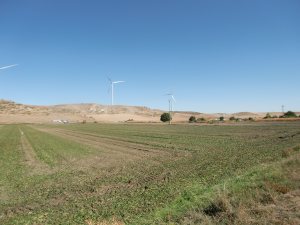This action took place on 23 July 1812, the day after Wellington‘s Anglo-Portuguese army defeated Marmont‘s French at Salamanca. A brigade of 770 heavy cavalry of the 1st and 2nd Dragoons of the King’s German Legion, commanded by General Georg Bock, supported by the 1,000 British light cavalry of General George Anson’s brigade encountered a French division of 4,000 infantry commanded by General Maximilian Foy.
The British monarch, King George III, was also Elector of Hannover. A large part of the Hanoverian Army escaped to Britain when the French invaded their country in 1803 and formed the KGL, which was part of the British Army.
Foy’s division had not been engaged at Salamanca, and it was acting as the rearguard for the retreating French army. His cavalry fled as the KGL advanced, so he formed his infantry into squares.
A square was a square or rectangular formation, at this time normally formed by a single battalion. Infantry caught in line or column by cavalry would be massacred, but were generally safe in a square. The British, whose lines were two men deep, formed squares that were four deep. The French, whose lines were three deep, formed squares that were either three or six deep. Squares were usually hollow, but solid ones could be formed to rally troops in an emergency.
Horses would not attack the rows of bayonets offered by a square, so disciplined infantry in a square were safe from unsupported cavalry. Cavalry could defeat squares by bringing up their supporting horse artillery, which would destroy the squares by firepower. All artillery was pulled by horses. The gunners of horse artillery, which had light guns, rode on the horses or limbers, so could move faster than the heavier foot artillery, whose gunners marched.
Infantry caught in the wrong formation because of errors by commanders or because the attacking enemy was concealed by terrain or poor visibility could be massacred. This happened to British infantry that was caught in line by French and Polish cavalry coming out of the mist at Albuera in 1811. The day before at Salamanca General Maucanne observed British cavalry advancing and formed his division into squares, only to be surprised by British infantry that attacked over the crest of a ridge.
Garcia Hernandez was a small action, but it is famous because it was the only battle of the Napoleonic Wars involving the British Army in which a formed square, of either side, was broken exclusively by cavalry.

Battle of Garcia Hernandez. Source: //upload.wikimedia.org/wikipedia/commons/e/e3/Garcia_Hernandez.svg
The KGL charged a square of the French 6th Light Infantry Regiment. It allowed the cavalry to get too close before firing, and a mortally wounded horse fell into the side of the square, creating enough of a gap for other cavalry toget inside the square. The square broke, with most of its members surrendering.
A second French square was shaken by this, and its men fled or surrendered when the German dragoons attacked it. Foy withdrew the rest of his division. According to Sir Charles Oman 200 Frenchmen were killed and 1,400 captured. The KGL lost 54 killed and 62 wounded. The reason for the high ratio of dead to wounded was the deadly effect of very short-range musket fire.[1]
The map in this post is from Wikipedia; link given in the caption. The photo was taken by myself when I visited the battlefields of Wellington’s campaigns of 1809-12 in a tour led by Ian Fletcher. I have no connection with Ian Fletcher Battlefield Tours except as a satisfied and repeat customer.
[1] C. Oman, Wellington’s Army, 1809-1814 (London: Edward Arnold, 1912), pp. 101-2.

